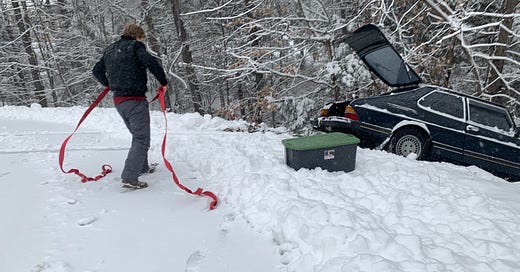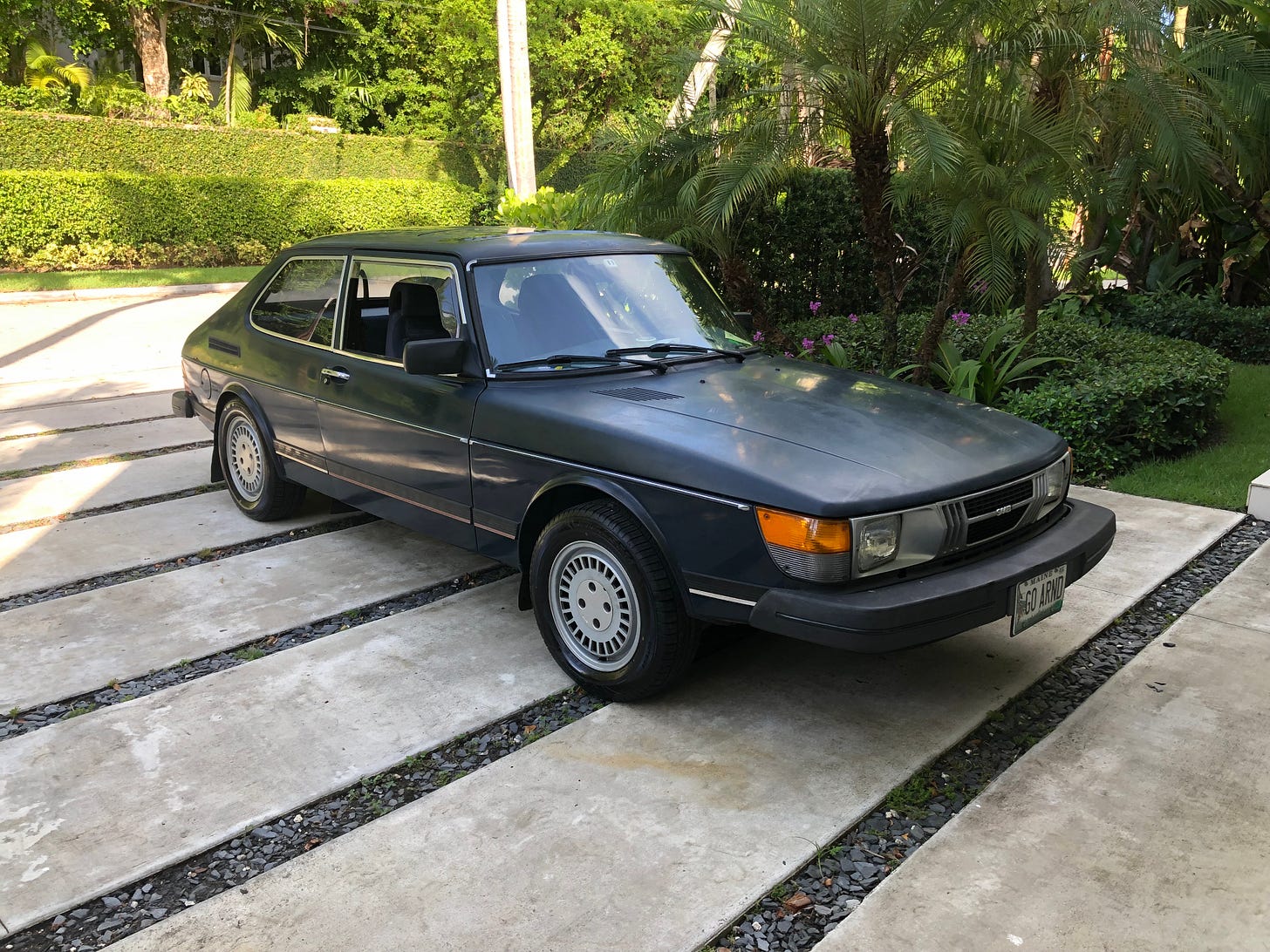Where There's Smoke, There's a Saab
Well, at least my Saab. Let's just say she's been a labor of love.
“I’m never riding in this car ever again!”
Those were the words screamed to me by my then-girlfriend as we sat in the front seats of my 1982 Saab 900S, the first car that I had purchased for myself, which had just experienced its second electrical fire – and the second one with her in the car. This time, it had simultaneously overheated and burned the battery cable to a crisp. Last time, the voltage regulator failed and the ‘90s-era Kenwood cassette player emitted the white smoke of death as we pulled to the side of the busy Florida Turnpike. It was January of 2023. The time before that was in June of 2022. Six months before that, I had stuffed the poor car into a ditch during my very first attempt at driving in the snow. Two out of those three times ended with us calling triple-A and waiting for a tow truck to arrive. One of them was remedied with a good yank-strap and a forty-dollar bribe to the neighborhood plow guy. I think I could see why she was upset.
I bought my Saab in August of 2021, and frankly, I don't know what I was thinking either. I had been working all summer long at a bar in downtown Miami, and we had just sold the family truck, replacing it with a bright-red 1991 Saab 900 Turbo convertible that had been in the family for almost thirty years. It was not only the vehicle that I drove to work every day, but it was also the family project car, receiving clutch work, a new convertible top, and a lot of overdue attention after sitting for nearly six years. Additionally, I was just two weeks away from going back to college for the fall semester and had no storage space, let alone a spot where I could keep a car that I wouldn’t touch for eight months out of the year. But, like any other crazed car enthusiast, rational thought wasn’t going to stop me. I found myself scrolling through classified ads for cars that I wanted, but I definitely didn’t need. On a whim, I opened the Saabnet.com classifieds section, and voila, there she was.
Aside from the pristine blue velour upholstery and an odometer that read just shy of 118,000 miles, she wasn’t particularly pretty by anyone’s sane standards. The faded Admiral Blue paint was cracked and in need of some serious help, and upon further conversation with the owner, I discovered that she hadn’t been driven much in years. The headliner had worn thin in some places. The rear speakers didn’t work due to a dead amplifier, which wasn’t quite bolted down in the space underneath the rear seat - a fact that should have given me an idea of the quality of the previous owner’s electrical work. The old Yokohamas had been manufactured before I had even entered middle school and were beyond dry-rotted. The warm-up regulator, an integral part of the antiquated Bosch K-Jetronic fuel injection system, wasn’t working at the moment, which made it tricky to get her started and idling well. But all of that went out the window when she cranked to life.
Saab’s B201 engine, a two-liter, eight-valve, slant-four derived from Triumph architecture, was by no means a powerhouse, even by 1982 standards. The naturally aspirated, fuel-injected variant made about 110 horsepower when new, and it had probably lost a few of those horses over the years. Needless to say, I wasn’t going to win any drag races. But, once I slid behind the wheel and took the long-throw shifter in my hand, none of that seemed to matter. At idle, she thrummed out a glorious, baritone beat of life through a three-and-a-half-inch glasspack muffler. As we took a test drive around the owner’s sparsely-populated, northern Georgia neighborhood, we let that little four-banger growl up past 3000 rpm and buzz like an angry wasp before gently upshifting the five-speed box. With a heel-toe downshift and careful input of the steering wheel, she body-rolled her way through the corners as the engine labored its way toward the upper rev range on corner exit. What a damn riot. I was smiling from ear to ear, and a quick look over my shoulder told me that the soon-to-be previous owner was grinning, too. Suddenly, the beat-up paint didn’t seem so bad. If anything, it fit the car more than ever. She was ratty, raspy, and a little worn around the edges, but she had a lot of soul left in her.
Once we got back to his house, I sat in the gravel driveway and just looked at her while he went inside to get the title. After spending my teenage years watching old rally videos, poring over Hot Rod magazines, and wishing so desperately to own a classic car someday, this was finally my chance. The simple, silver headlight buckets looked retro. The wind-swept radio antenna added a hint of speed to her look. The 15-inch Ronal turbofan wheels and the heavy-duty mud flaps just screamed ‘80s rally. Without hesitation, I pulled out the envelope with $2500 cash and started counting out the bills. That was it. I had to have it.
I hadn’t told my mother that I was flying to Georgia to buy a forty-year-old car and drive it back. In fact, the only two people who did know were my dad, who had enabled my habit by driving me to the airport that morning, and my then-girlfriend, who was more concerned about my safety than I was, apparently, and didn’t think it was funny when I remarked that there was no cell service at the previous owner’s house. Note to self: it’s a good idea to tell a loved one that you’re going to do something stupid before you do it. It’ll save you a lot of trouble, and if the seller turns out to be a serial killer, it’ll give your family something to say if you end up in the obituaries.
The drive home was uneventful, and after getting the “I’m not mad, I’m not shocked, I’m just disappointed” talk from my mother, I quickly set about making the Saab reliably roadworthy. Four new Sumitomo HTRs were mounted, balanced, and installed. The only local Saab specialist, a semi-retired guy who worked part-time at a local auto shop, gave the suspension and underbody components a good look-over and gave me the thumbs-up to drive her as much as I wanted. I gave it an oil change, a tune-up, and a new fuel filter, following an accidental running-on-empty incident where I discovered that the fuel gauge was not accurate. Then, I loaded her down with all of my college stuff and hit the road. It was Maine or bust.
For the next ten months, Lucy Blue, as she was now called, was a reliable instrument of transportation. (Yeah, right.) Okay, she had her issues, but it wasn’t all bad. While up at college, I drove her nearly 8,000 miles, including on a few recurring weekend trips to Boston, during which I recovered the powertrain out of a Saab 900 Turbo to rebuild as a spare. Lucy Blue towed U-Haul trailers at highway speeds, made a few hundred-mile trips to athletic events, and, at more than one point, achieved a staggering 31 miles per gallon. Sure, I had to replace countless parts, like a fuel injector line that was spraying onto the exhaust manifold, a brake fluid reservoir cap that was temporarily replaced by pink duct tape, and a pair of dead horn buttons that made me public enemy number one at 7 a.m. on a Monday. But despite the setbacks, the breakdowns, and the occasional irritation, it was worth it.
It’s safe to say that there’s more to this experience than just enjoying an old car. “It’s a hobby,” my mother would say to me when I came inside cursing about a blown power steering line. “It’s a project car,” she said when I considered driving it 1100 miles during the last winter break. But I don’t think she gets it. To me, Lucy Blue is more than just a project car, or a hobby, or even just a means of transportation. She’s a way to learn the things that are beginning to be forgotten, whether those are memories, tech tips, or important specifications. She forced me to learn the things I didn’t know and practice the things I did. I learned how to tune the car the broke and old-fashioned way: by smell, sound, and butt dyno. I devised solutions to irritating problems, like how to get an alternator bolt out when it’s rammed up against the firewall. I had to think ahead and come up with ways of sourcing or rebuilding parts that are no longer in production, preferably before they failed and left me on the side of the road for the umpteenth time. Without having bought my ‘82 Saab 900S, I would have never enjoyed every gas station fill-up, where bluehairs would come up to me and spill old stories about Saabs of eons past. I would have never discovered The Saab Place, a shop located just down the road from my college that saved my bacon countless times by repairing my car when I had too much on my plate. It’s also where I learned more about the intricacies of this car than anywhere else, and for that I am eternally grateful. In a world where Saabs on the road are becoming fewer and fewer, I suppose someone has to know how to keep them alive. It might as well be me.
Today, Lucy Blue is in a parking garage in South Florida, where my dad starts her up every Friday. She’s completed 131,000 miles and has a million left in her. I’ve done a ton of work to her, but I still have plenty to go. Someday, she’ll teach me how to do bodywork, allowing me to cut out her cancerous rust and make her Admiral Blue paint glimmer in the sunlight once again. Another day, she might teach me how to rewire a car from bumper to bumper, giving me a chance to prevent future electrical fires and relationship drama. Maybe she’ll even be the car that gets my first engine swap, whether that be a blown small-block Chevy or the ‘88 900 Turbo motor that’s sitting in my dorm room. Whatever her path is, it’s sure to put a smile on my face every time I slide behind the wheel.







